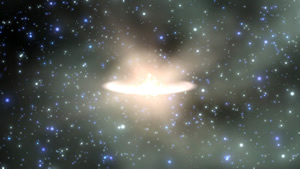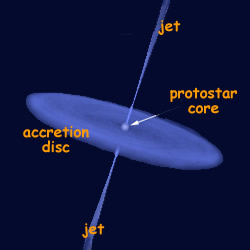 Gravity is the force that pulls matter together - it is an attractive force that acts on masses. It acts on the dust and gas together. It pulls in gas and dust from a vast area - steadily building up the mass of the 'star'. This is called accretion.
(Accretion is a process in which the size of something gradually increases by steady addition of smaller parts}. Gravity is the force that pulls matter together - it is an attractive force that acts on masses. It acts on the dust and gas together. It pulls in gas and dust from a vast area - steadily building up the mass of the 'star'. This is called accretion.
(Accretion is a process in which the size of something gradually increases by steady addition of smaller parts}.
 As the cloud continues to contract there is conversion of gravitational energy of the particles to thermal kinetic energy. So a s the matter is pulled together it swirls ever faster (like water going down a plug hole!).
This results in the matter getting even hotter and the pressure building up. It also results in the gas and dust forming a disc shape with a concentration of mass in the middle or core of the protostar. As the cloud continues to contract there is conversion of gravitational energy of the particles to thermal kinetic energy. So a s the matter is pulled together it swirls ever faster (like water going down a plug hole!).
This results in the matter getting even hotter and the pressure building up. It also results in the gas and dust forming a disc shape with a concentration of mass in the middle or core of the protostar.
Some of the material from the disk is ejected outward in a bipolar jet. Jets of fast moving particles can be detected coming out at right angles to the accretion disc.
It gives out radiation from atoms that are excited due to their high kinetic energy collisions - but at this stage there is no fusion going on.
The outer parts of the disc might clump together to form planets and the inner core will gather most of the matter into the central star (or even stars - binary systems develop two from the central core). At last the surrounding gas/dust envelope disperses and accretion process stops, the star is considered as pre-main sequence star.
 to go to the next stage - the Main Sequence of a Star's Life to go to the next stage - the Main Sequence of a Star's Life
 to find out about the Death of a Star to find out about the Death of a Star
 to for the summary diagram of the Life Cycle of a Star. to for the summary diagram of the Life Cycle of a Star.
|


